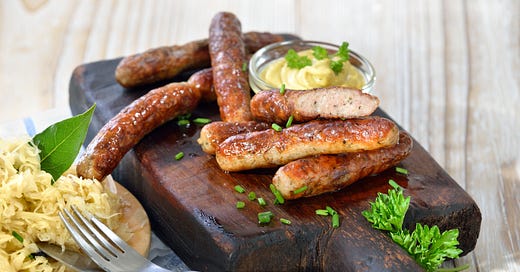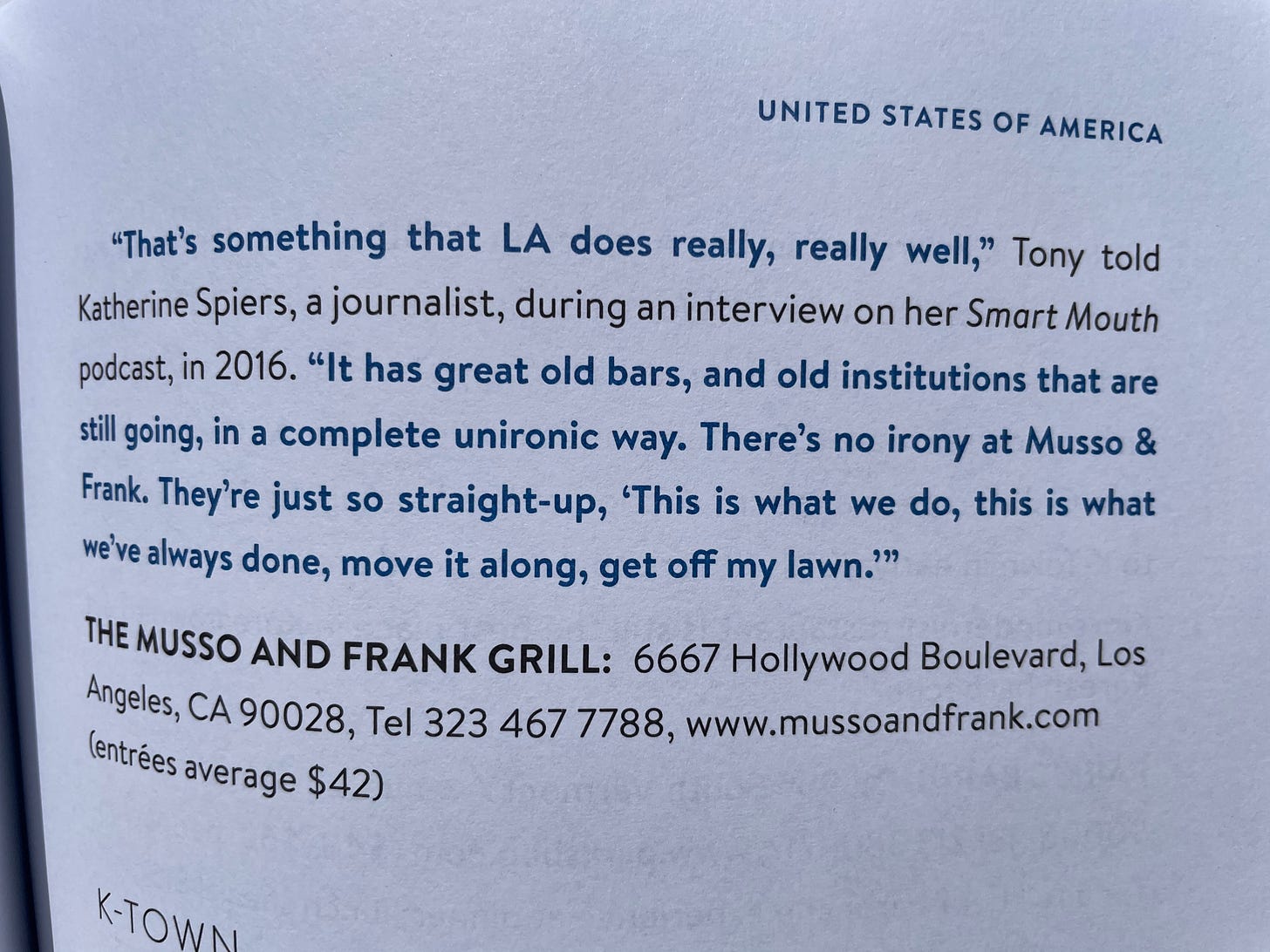If you enjoy the newsletter today, please forward it to someone who’d enjoy it, and tap the heart icon above, which will help me reach more readers. I appreciate your help, y’all!
This is the free edition of Smart Mouth. If you like it, consider a paid subscription. *If you would like to give less than $5, you can do that via Patreon, and it is very helpful and appreciated!
I’ve been on Yelp a ton lately for various reasons, and I really think it should be banned. I can’t tell you how many restaurant reviews I’ve read that complain that a third-party delivery service took a long time and the food was cold, and accordingly, the reviewer will be leaving one star. Jiminy Christmas.
In more positive news, Laurie Woolever did a Grub Street Diet, and she may have perfected the form. And I am not just saying that because she included me and my podcast in her book:
This is World Travel: An Irreverent Guide, co-written with Anthony Bourdain. I am hugely honored to be included, and will someday soon celebrate with a martini at the grill bar. (That’s the coolest part of Musso & Frank. No one agrees with me, but I’m right.)
[Whisky with Anthony Bourdain] [Transcript]
Nuremberg's Must-Try Sausage is 700 Years Old and Fits Through a Keyhole
Wandering the streets of Nuremberg, it’s impossible not to notice the prevalence of sausage. Vendors in cozy huts service pedestrian areas with rows of sizzling wurst and bucket-sized mustard dispensers, while A-frame chalkboards alert restaurant passersby to the opportunity to grab an on-the-go “Drei im Weggla” (Franconian for three in a roll). Year-round, there’s the unmistakable smell of grilled sausage in the air.
Among the many hundreds of varieties of sausage found throughout Germany, the one most dear to this city is the Nürnberger Rostbratwurst. An all-pork sausage with a fat content topping out at 35%, the essence of a Nürnberger is its marjoram-forward flavor profile. Oh, and its diminutive proportions.
Nuremberg sausages — which are a Protected Geographical Indication (PGI) food of the European Union — must measure between 7.0 and 9.0 centimeters in length (that’s 2.75 and 3.54 inches) and weigh no more than 25 grams (or 0.88 ounces) each. Since records indicate that Nuremberg’s sausage-making pursuits date back to 1313, there’s been ample time for theories to develop as to why the parcels of pork are so small.
The first, and perhaps most logical, explanation is that the exacting standards set forth by the butcher’s council in the 14th century demanded quality over quantity. Bratwurst that did not meet expectations for ingredients, texture, and flavor met instead with the Pegnitz river, which flows conveniently through the city center. As desire for the best of the wurst increased over subsequent decades, so followed the price of pork and spices. In a clever bid to boost profit margins during the late 16th century, butchers reduced the size of their bestselling marjoram sausages and, despite what equated to a per-kilo price hike nearly six times that of conventionally sized bratwurst, locals continued to buy with fervor.
A more fanciful story says that Nuremberg sausages are intentionally tiny so as to facilitate their swift passage through the keyholes of city gates, prison cells, and tavern doors. A sympathetic guard could feasibly slip a sausage or two through a locked gate and quiet the rumbling stomachs of wayward residents or dispirited prisoners, while carousers in want of a late-night bite might get lucky with the “take a sausage and get out of here!” mercy of an innkeeper after hours.
But the better experience is sitting down to a platter of six, eight, or ten Nürnbergers, paired with sauerkraut or vinegary potato salad and a cold wheat beer.🌭
More Food Reading:
Working in restaurants is difficult and pays poorly, and now employees have to be mask enforcers, too? I wouldn’t want to go back to work, either.
So the broken ice cream machines at McDonald’s are … by design.
A history-heavy cookbook filled with recipes that may soon be completely forgotten. It’s on my wishlist!
A Southern Black woman had a cooking show in Louisiana in the 1940s.
Annie of Annie’s mac and cheese is a real person!
This newsletter is edited by Katherine Spiers, host of the podcast Smart Mouth.
A TableCakes Production.
Want to contribute? Here are the submission guidelines.






Down with Yelp!!! Don't know if you've seen these yet, but you'll appreciate them if you haven't: https://mymodernmet.com/national-park-review-posters-amber-share/